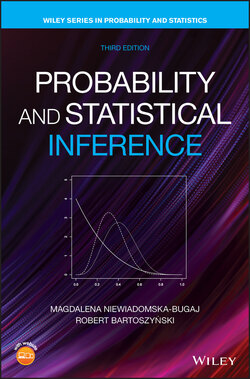Читать книгу Probability and Statistical Inference - Robert Bartoszynski - Страница 80
Example 3.6
ОглавлениеAs an illustration, let us evaluate , which we will use later. We have
Multiplying the numerator and denominator by we get
(3.11)
In this section, we tacitly assume that is an integer with .
Observe also that the symbol makes sense for and , in view of the convention that . Thus, we have
(3.12)
for all integers and such that . For , we have , since there is only one empty set, and since only one set of size can be selected out of a set of size . Formula (3.12) gives correct values, namely
(3.13)
We will now study some properties of the binomial coefficients . First,
(3.14)
which follows from the symmetry in formula (3.10). One can also prove (3.14) by observing that choosing a set of size is equivalent to “leaving out” a set of size . The number of different sets of size chosen must be equal to the number of different sets of size “chosen” by leaving them out.
We will now prove the following theorem:
Theorem 3.3.2 (Pascal's Triangle) The binomial coefficients satisfy the relation
(3.15)
Proof: The formula can be easily proved by expressing the left‐hand side using (3.8) and reducing it algebraically to get the right‐hand side. It is, however, more instructive to rely on the interpretation of the coefficients as . The right‐hand side of (3.15) counts the number of sets of size that can be chosen out of a set of size . Let us take one element of the latter set and label it somehow. We have then a set of unlabeled and labeled element. Each subset of size is one of the following two categories: (1) subsets that contain only unlabeled elements, or (2) subsets that contain unlabeled elements and one labeled element. The two terms on the left‐hand side of (3.15) count the numbers of subsets of the first category and of the second category.
The name Pascal's triangle reflects a way of obtaining the coefficients . We build Pascal's triangle starting with the top row (counted as the zeroth row), which consists of the single number 1 (see Figure 3.1). Then we obtain each number in the subsequent rows as a sum of two numbers directly above it (as marked with arrows in the fifth row). The consecutive numbers in the th row are, reading from the left, the values of
so that, for example, , as marked on the triangle in Figure 3.1. While the Pascal triangle was very useful in the past, today it is of a historical value as statistical packages are used to obtain values of binomial coefficients.
Figure 3.1 Pascal's triangle.
The name binomial coefficient is connected to the following formula:
Theorem 3.3.3 (Newton's Binomial Formula) For any positive integer and real , we have
(3.16)
Proof: We will prove the theorem by induction. For , the right‐hand side equals . Assume now that the assertion holds for some , and multiply both sides of (3.16) by . Then
Separating the term for in the first sum, and the term for in the last sum, we may write
where the last equality is due to Theorem 3.3.2.
The following theorem is an immediate consequence of Theorem 3.3.3 applied to and , respectively.
Theorem 3.3.4 The binomial coefficients satisfy the identities
(3.17)
and
(3.18)
We also have the following theorem:
Theorem 3.3.5 For every and every
(3.19)
Proof: Consider the product . Expanding the right‐hand side, we obtain
(3.20)
while the left‐hand side equals
(3.21)
For , comparison of the coefficients of in (3.20) and (3.21) gives (3.19).
As a consequence of (3.19), we obtain a corollary:
